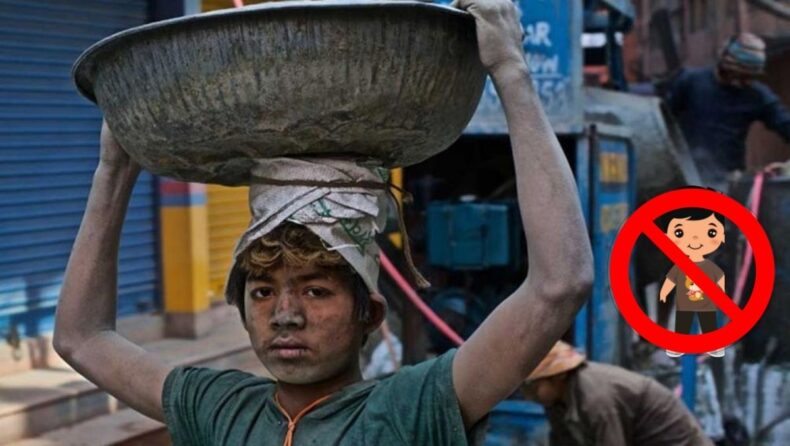The Indian government is dedicated to ending child labor in the country. Our Constitution protects children from being involved in economic activities and occupations that are inappropriate for their age (Article-24). The Constitution’s Directive Principles of State Policy reaffirm this commitment.
Articles 23 and 24 of the Indian Constitution provide the right to be free from exploitation. These are crucial Fundamental Rights that safeguard every person from any kind of forced labor. Article 24 forbids the employment of minors under the age of 14 in any factory, mine, or other dangerous activity such as heavy industry, construction, or railroad.
Article 24 – Prohibition of child labor in factories and other workplaces. “No child under the age of fourteen years should be hired to work in any industry or mine or engaged in any other dangerous occupation,” according to Article 24. This Article expressly prohibits the employment of minors under the age of 14 in any hazardous industry, factory, or mine.
Children may, however, be employed in non-hazardous job. However, it does not exclude them from working in any non-harmful or innocuous capacity.
Convergence of Government Programmes:
As Child labor is an outcome of various social-economic problems such as poverty, economic backwardness, lack of access to basic services, illiteracy etc, the Government is taking very focused and concerted efforts towards the convergence of the ongoing developmental schemes at the Central Government, State Government, and the District level.
The government of India’s initiatives to bestow certain rights and schemes for Employment Generation and Social Security is all part of the efforts to eliminate child labor. Under the revised NCLP guidelines, much emphasis has been given to its convergence with Serva Siksha Abhiyan (SSA) and other schemes.
School uniforms and textbooks for each child in the NCLP schools (STCs) are sought under SSA whereas nutritious cooked mid-day meal is ensured through the Mid-Day Meal (MDM) scheme of the Government. The provision of primary health care including health checkups and maintenance of health cards is also provided through School Health Programme under NRHM.
The educational rehabilitation of the children is also to be supplemented with the economic rehabilitation of their families. The Government is adopting a sequential approach with a focus on proper rehabilitation of not only the working children but their families also through the revised NCLP scheme and convergence of various developmental schemes of the Government.
Ministry of Women and Child Development is to provide food and shelter to the children withdrawn from work through their schemes of Shelter Homes, etc as part of the Integrated Child Protection Programme.
Ministry of Rural Development is to provide employment opportunities to the parents of the children near their place of residence under MGNREGA. Ministry of Consumer Affairs, Food, and Public Distribution are to provide subsidized food grains under the Food Security Act.
In 2006, the government banned the employment of children as domestic servants or workers in business establishments like hotels, dhabas, restaurants, shops, factories, resorts, spas, tea shops, and so on. It warned that anyone employing children below 14 years of age would be liable for prosecution and penal action.
Child Labour (Prohibition and Regulation) Act, 2016

Image Source : Analog IAS Institute
The Child Labour (Prohibition and Regulation) Amendment Act, 2016, amended the Child Labour (Prohibition and Regulation) Act, 1986. It has renamed the Principal Act the Child and Adolescent Labour (Prohibition and Regulation) Act, 1986.
The Amendment Act prohibits the employment of children below 14 years in all occupations and processes. Earlier, this prohibition was applicable to 18 occupations and 65 processes. Further, the Amendment Act prohibits the employment of adolescents (14 to 18 years of age) in certain hazardous occupations and processes.
This amendment allows the child labor in “the family or family enterprises” or allows the child to be “an artist in the audio-visual entertainment industry”.
Working hours not mentioned, Only the mention that children may work after school hours or during vacations. This provision is not beneficial for families trapped in intergenerational debt bondage, even it is a known fact now that kids in reality TV shows suffer from depression and anxiety and pressure to perform better.
Child Labour Related Acts
· The Employment of Children Act, 1938
· The Factories Act, 1948
· The Plantation Labour Act, 1951
· The Motor Transport Workers Act, 1951
· The Mines Act, 1952
· The Merchant Shipping Act, 1958
· Apprentices Act, 1961
· The Bidi and Cigar Workers Act, 1966
· The Child Labour (Prohibition and Regulation) Act, 1986
In 1996, the Supreme Court directed the establishment of the Child Labour Rehabilitation Welfare Fund in which the offending employer should deposit a fine of 720,000 for each child employed by him.
It also issued directions for the improvement of education, health, and nutrition of children.
Conclusion
Our Constitution provides for protection of children from involvement in economic activities and avocations unsuited to their age and this is provided for in the Fundamental Rights (Article-24). Directive Principles of State Policy in the Constitution also strongly reiterate this commitment.
Provision of Child & Adolescent Labour Rehabilitation Fund: In order to give the statutory back up for the rehabilitation Fund, the Government has made a provision in the Child Labour (Prohibition of Regulation) Amendment Act, 2016 for constitution of Child & Adolescent Labour Rehabilitation Fund at district level to ensure that child and adolescent is not only rescued but his future is secured by the amount collected in fund for his welfare and education.
The amount of fine realized from the employer of the child or adolescent shall be credited in the rehabilitation Fund and an amount of fifteen thousand will also be credited by the appropriate Government for each of the child and adolescents rescued from the work.
Child labor is a national embarrassment. It is a deplorable practice that jeopardizes the well-being and development of both children and the entire nation. There are around 30 million child laborers in India. This is horrific, and it is past time to put an end to this heinous practice and punish those who engage in it.
Edited By : Khushi Thakur
Published By : Shubham Ghulaxe













